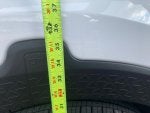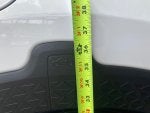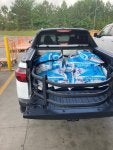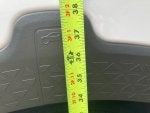No guarantee but likely the SC rear shocks are using the patented Nivomat technology. I was interested in it, read it, and this weekend had a chance to test it. The below pictures show the empty standard ride height 38”, then I loaded 960 lbs of softener salt it dropped to 35.5”. If felt “wiggly” in the rear as I pulled out, within a mile about it seemed to stabilize and the vehicle tightened up noticeably. After an 18 mile interstate run at 70mph I unloaded and the rear suspension was up to 36.5”. Pointless to state the specifics of what my QX56 can handle but its rear air leveling suspension can just level back out if I keep the tongue weight below 500ish lbs so I’m impressed with this system providing an inch lift with 1000 lbs in the bed. I doubt it’s design is supposed to lift to original ride height anyway. The bed lifted to 38 3/8” as soon as I unloaded, forgot the final pic but you’ll have to trust that after 3 miles to the next store it had settled back to right at 38”. Tire temperature for those interested stabilized quickly on the interstate at 39psi indicating around a 25ish degree increase in tire temprature.

Nivomat? Self leveling power
Maz
Discussion starter
136 posts
·
Joined 2022
- Add to quote Only show this user
No guarantee but likely the SC rear shocks are using the patented Nivomat technology. I was interested in it, read it, and this weekend had a chance to test it. The below pictures show the empty standard ride height 38”, then I loaded 960 lbs of softener salt it dropped to 35.5”. If felt “wiggly” in the rear as I pulled out, within a mile about it seemed to stabilize and the vehicle tightened up noticeably. After an 18 mile interstate run at 70mph I unloaded and the rear suspension was up to 36.5”. Pointless to state the specifics of what my QX56 can handle but its rear air leveling suspension can just level back out if I keep the tongue weight below 500ish lbs so I’m impressed with this system providing an inch lift with 1000 lbs in the bed. I doubt it’s design is supposed to lift to original ride height anyway. The bed lifted to 38 3/8” as soon as I unloaded, forgot the final pic but you’ll have to trust that after 3 miles to the next store it had settled back to right at 38”. Tire temperature for those interested stabilized quickly on the interstate at 39psi indicating around a 25ish degree increase in tire temprature.
Attachments
-
434.7 KB Views: 549
-
377.3 KB Views: 155
-
418.7 KB Views: 161
-
666.6 KB Views: 169
-
401.5 KB Views: 171
129 posts
·
Joined 2021
Thanks for the emperical data! My casual, eyeball observation had been that it seemed to self-level pretty well with various different loads, but I haven't put 1000 lbs in the bed yet. Glad to see it can keep up. (mostly) I didn't want to mess with a system that worked so well, so I was careful to get the rear shock extensions along with my Truxxx lift kit (front & rear lift) so that the shocks would still sit in the correct part of their stroke to properly self-level. So far it seems to be working great.
Thanks again for the data based observations!
Thanks again for the data based observations!
4,560 posts
·
Joined 2021
Thanks for doing this the right way. Most people don't understand the self leveling system requires driving the vehicle for a few miles for it work its magic.
1,299 posts
·
Joined 2021
Yeah, from what I understood, inside the shock is basically an internal air spring, and when it detects its sagging (not quite sure on how) it will use the up and down motion of the suspension to pump up that air spring to increase the spring rate. Then when it detects the load is gone, it will deflate to reduce the spring rate and soften the unloaded ride. There are surely limits though to how much extra spring rate the air-spring can add, so naturally with enough weight the suspension will still compress but to a lesser degree than if it had no extra air-spring, and without the overly stiff truck like ride of just always driving around with an overly heavy rear spring when unloaded.
4,560 posts
·
Joined 2021
This website describes the shocks: Nivomat Shock Absorbers: Self-Leveling Monotube Ride Control Units it appears to use oil and air pressure to control the leveling motion.
Based on the diagrams of the shock's internals I believe this is how it works:
The leveling is controlled by a two valves, one is set as the "low" position while the other is set at as the "high" position. When the shock moves up or down during normal driving an internal diaphragm passes one of the valves depending on the load (weight of the vehicle). In this new position a bypasses condition occurs. During bypass the internal shock damper sends pressure into a different area of the shock tube which pushes the whole shaft up or down. This action will raise or lower the vehicle (like pumping the handle of a floor jack) until the opposite end of travel is reached by the shaft - which causes the opposite valve to become the bypass. As the vehicle continues bouncing along at some point the pressure equalizes and diaphragm remains inside a "normal" zone between the two valves - and then the vehicle is level again. If the load changes (IE: you add or remove weight) the shock will move outside the normal zone causing the whole process to repeat again. Regardless of direction (up or down) the system is always trying to stabilize in the normal or level zone if possible.
The system is brilliant in simplicity as it uses the natural way shock absorbers / dampers already work. The only difference is the pressure created by the shock compression is redirected by the valves to increase or decrease the overall lift force of whole system. I can only imagine that driving in the low position would result in excessive wear on the valves or diaphragm. This might be where the infamous 660# weight limit for the bed comes from, but that is pure speculation on my part.
Most the articles I found reference Volvos but other OEMs use these type of shocks.
Based on the diagrams of the shock's internals I believe this is how it works:
The leveling is controlled by a two valves, one is set as the "low" position while the other is set at as the "high" position. When the shock moves up or down during normal driving an internal diaphragm passes one of the valves depending on the load (weight of the vehicle). In this new position a bypasses condition occurs. During bypass the internal shock damper sends pressure into a different area of the shock tube which pushes the whole shaft up or down. This action will raise or lower the vehicle (like pumping the handle of a floor jack) until the opposite end of travel is reached by the shaft - which causes the opposite valve to become the bypass. As the vehicle continues bouncing along at some point the pressure equalizes and diaphragm remains inside a "normal" zone between the two valves - and then the vehicle is level again. If the load changes (IE: you add or remove weight) the shock will move outside the normal zone causing the whole process to repeat again. Regardless of direction (up or down) the system is always trying to stabilize in the normal or level zone if possible.
The system is brilliant in simplicity as it uses the natural way shock absorbers / dampers already work. The only difference is the pressure created by the shock compression is redirected by the valves to increase or decrease the overall lift force of whole system. I can only imagine that driving in the low position would result in excessive wear on the valves or diaphragm. This might be where the infamous 660# weight limit for the bed comes from, but that is pure speculation on my part.
Most the articles I found reference Volvos but other OEMs use these type of shocks.
13 posts
·
Joined 2022
Had anyone had problems with the rear suspension? Since about a year ago my rear shocks have been making noise when I go over bumps. And nothing is in the bed that will rattle. Looks like the Hyundai warranty doesn’t cover suspension. But I think I found an eibach suspension kit that supposed to lower the truck about 2 inches that’s cost the same is one Hyundai original shock. Ideas or opinions please
378 posts
·
Joined 2023
Friend with a Telluride (same self-level rear shocks) had what sounded like a rear wheel bearing go out, turned out to be the shock mounting point insulation had degraded and it was covered by the warranty. So yes, struts/shocks are 'maintenance' items unless they prematurely fail, but are you sure it's the strut/shock that failed?
13 posts
·
Joined 2022
I have not inspected it yet, so I am not 100% sure. I’m just preparing for the worst possible scenario which would be to replace the shocks.
1 post
·
Joined 2023
You mention an after market rear shock replacement kit. Could you provide more information on that kit. I don't need the self leveling, and want to get rid of the noise from the rear shocks. They were replace recently and still make noise. Thank You
13 posts
·
Joined 2022
I finally inspected my rear shocks and they are leaking badly. I bought the extended warranty and apparently fly they are considering it covered. So I’ll be taking to to the Dealer to handle that. Hopefully it is handled quickly.
-
?
-
?
-
?
-
?
-
?
-
?
-
?
-
?
-
?
-
?
-
?
-
?
-
?
-
?
-
?
-
?
-
?
-
?
-
?
-
?
- posts
- 146K
- members
- 13K
- Since
- 2015
We’re a forum community dedicated to Hyundai Santa Cruz pickup truck owners & enthusiasts. Come join the discussion about upgrades, towing capacity, reliability, and more!
Top Contributors this Month
View All
BeastofBurden
28 Replies
crmccomb75
25 Replies
RichmondHawk
23 Replies








